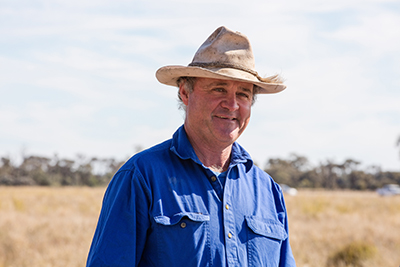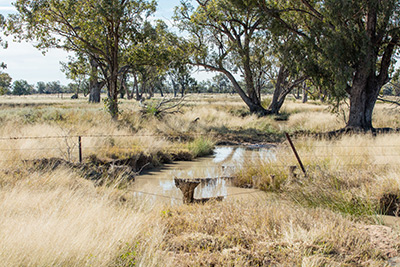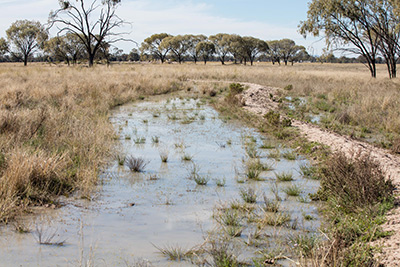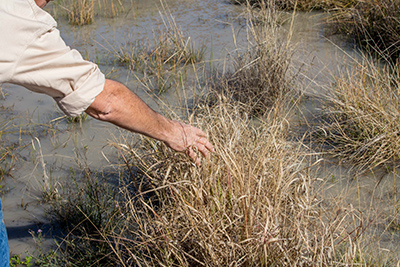Turning tin into gold at Wee Waa
A riparian area has been revitalised and a paddock described as the ‘hardest country on the place’ has added a biodiverse and productive showcase on the Dixon’s farm near Wee Waa in North West NSW.

Jason Dixon
Jason and Kate Dixon were in the grip of drought when they approached their local North West Local Land Services (NWLLS), branch in Narrabri in 2019. It was this initial enquiry to NWLLS’s Angela Baker about potential assistance to clean out stock dams, that put the Dixons on a path to successfully rehabilitating areas of their property, where they run dorpers and small cattle numbers. They’ve improved drought tolerance for the future, productivity, biodiversity and maximised benefit from rainfall. Jason and Kate are also now active members of their local Landcare group, hosting farm walks and talks to share their relatively short, yet impressive journey. Local Land Services has been with them throughout.
“After Jason’s initial enquiry, I had a look at the map to see where his property was and he happened to be on a creek that was a priority for riparian funding at the time,” Angela said.
“I asked if he would be interested in fencing his creek off and that way we could also contribute to having his dams cleaned out as well as installing new stock watering troughs.
“When I visited the property, we discussed other avenues of funding and I suggested that along with fencing the creek, perhaps water ponding could be suitable on his scalded country: he was interested and it went from there.”
Work began in 2019 on both projects and the Dixons are thrilled with the results. The fenced riparian area along the creek has created groundcover along the banks, which has improved water quality. Installing additional watering points (dams and troughs) has relieved pressure on the stream, and is no longer the main watering point, which creates a more managed grazing regime for the riparian zone.
“The fencing definitely helped regenerate this area,” Jason said.
“We still graze it, but shorter term and leave plenty of groundcover.”

Womera Creek is more stable and healthy now that stock only access for a limited time instead of using as a permanent water source.
The ponding site covers around 20 hectares of what was previously extremely low production, scalded clay pan. Jason says wryly that one of his neighbours described it as ‘hard as corrugated iron and about twice as productive’. However, a remarkable turnaround has been achieved using a method known as ponding, which consists of a series of small earthen banks to slow the movement of water across the landscape.
Jason says the issue they were trying to solve was lack of groundcover, caused by a cycle of water shedding in rain events and erosion.
“During the drought the wind was actually blowing the soil away,” he said.
“When we did get rain, due to the water just shedding off across this paddock, with no infiltration, it was impossible to get grasses and pastures going.
“Angela suggested ponding may be a system that could work well here, to temporarily hold up the water, so with their support we began work.”
Installing the system in late 2019 required an initial survey, erection of the small bank configuration using a grader followed by planting a perennial tropical grass mix. Rain in early 2020 kicked the system into gear. Now with successive rain events, the bambatsi panic and other tropical perennial grasses are going well: helping the natives recover and choking out undesirable weeds.

The water ponding banks were surveyed and marked out according to slope and soil type then constructed using a grader.
Jason said he could see an almost immediate and then continual improvement in the soil.
“The water used to lay on the top but groundcover has now helped infiltration,” he said.
“When this work was first done, water sat here for a long time,” he said.
“But after each rainfall, I noticed it started to penetrate more quickly and the soil began holding more water.
“There is also the return of native species, and winter herbage, which I haven’t seen on this block before and a reduction in some pretty ordinary weeds.
“I’ve got a great mix here, which is what I want to see, and some native species coming back, which is the goal.”
Hard to manage weeds such as spiny burr grass and galvanised burr have been drastically reduced.
“This country was covered goats head, but it doesn’t like wet feet and already the only plants that are left here are growing in higher areas along banks,” Jason said.
“We really have to take notice of what we see in our paddocks”.
“If I’ve got too much of one thing I reckon I’ve got a problem, so I like to see a lot of different plants spread around.”
Like most landholders who rehabilitate land in this way, the increased biomass being created doesn’t mean the Dixons will increase stocking numbers. It’s more about taking the long view and giving the country more legs in harder times.
“I could go higher but I won’t,” he says.
“I destocked during the last drought, and this project has allowed me to be better prepared for drought, because my country will hold up better because it is healthier.”

Increased groundcover, biomass and diversity of plants in the ponded areas will help carry the property through the next dry period.
The rehabilitated site, which sits along a busy road into town, has also attracted interest from other landholders, and Jason says people have noticed the change. Being involved in the LLS project has led to Jason becoming a member of the local Yarrie Lake Landcare Group, and his farm a showcase, hosting a field day and farm walk.
This initial project has put Jason and Kate on a path to keep improving.
“I definitely want to do more,” he says, “the more useable grass and groundcover I can generate in a sustainable way, the better.”
Under the Catchment Action NSW program funding was provided to undertake ponding earthworks, with perennial grasses sown behind to rehabilitate scalded land.
Outcomes have been:
- Increased grazing productivity
- Improved drought resilience
- Improved soil quality, ground cover and pasture
- Reduction in weeds and return of native species
- Reduced erosion.
Funding was provided to improve the condition of streambank of Womera Creek by undertaking fencing, water infrastructure, vegetation management and feral animal control.
- Increased groundcover.
- Return of native grasses.
- Improved water quality.
Download a PDF of the case study PDF, 847.09 KB. You can also view the video on our YouTube channel.